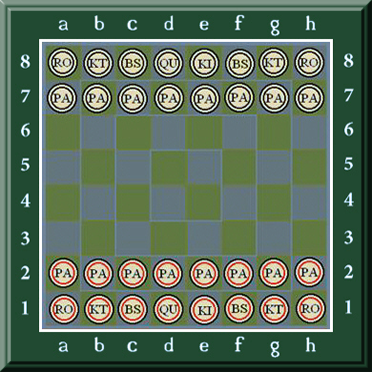|

“Pawns are not allowed to retreat from battle”
The King is allowed to move one cell diagonally, forward, back, or horizontal on the Chess board. At the extreme left and right of each player a Rook is inserted. Notice that there are not one, but two Rooks, Rook 1 and Rook 2. To the left and right of the King and Queen are two Bishops (Bishop 1 and Bishop 2). However, you will have noticed that these two Bishops operate on different
colored diagonal cells (one for the light and one for the dark cells).
Although the two Bishops move with the same diagonal movement they never come into contact with each other during a game. One Bishop is quite powerful and can sweep diagonally the length and breath of the board. Bishop 1 and Bishop 2 used together are an even more formidable force to contend with.
To the left and right of the Bishops are placed two similar moving Knights (Knight 1 and Knight 2). These move in a 2 x 1 fashion and also have the ability to jump over the heads of all other pieces including the King and Queen.

To the front of these powerful pieces are inserted eight pieces (Pawns) that are representative of the army of soldiers who can be promoted/enrobed if they do well in battle and disposed, or sacrificed if and when the need arises.
These soldiers, or Pawns are not allowed to retreat from battle unlike the more powerful major pieces who can run and escape during a conflagration. With the pieces in place the Chess board is complete and ready for action.
At the far end of the board a similar army of belligerents are assembled and between the two opposing sides are four ranks comprising 32 cells on which to move forward and into the fray. A board of 8 x 8 has a total of 64 cells. You could have a board of 9 x 9, 12 x 8 or, any conceivable combination of vertical and horizontal cells of your choosing. A total of 32 pieces are placed on the traditional Chessboard.
Due to the fact that a board is 8 x 8 cells in size, this limits the total number of pieces to 16 for each opponent and allows space for them to advance without getting in each others way, while at the same time enabling both sides to get their hands on one another.
This then, is the traditional Chessboard which has been handed down through the centuries by our ancestors who made various modifications to the rules as the need arose.
There were no alterations regarding the number of cells in the centuries that followed. The 8 x 8 board became the accepted final standard.
Modifications have included introducing the "e.p." (en passant) rule during the middle ages and permitting the Pawn to move 1 or 2 cells forward on the initial move (first
move option). From the 16th century onwards the game of traditional Chess became quite popular and when the printing press was invented it became a pastime the layperson could engage in during their leisure hours.
Today traditional Chess columns appear in many daily newspapers, The London Times being an excellent example, and magazines. TV coverage of major events, video and CD ROM's are also an imposing resource and quite popular.
Sixty-four cells
There is reason to suspect that the 64 cells (Level 1, 8 x 8 board) is based on the military formations of the Alexandrine phalanx and the parataxis and of those of the later Byzantine period.
|